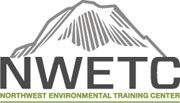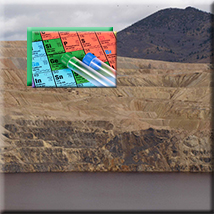Description: **If this course has Remote Live Attendance -- USA as the location, it is a live stream remote course. You will need a computer and an internet connection. **If this course has a city and state as the location, we will be attempting to hold the course in-person at the listed location with course times listed in the host city's time zone; however, due to gathering restrictions and health concerns, NWETC reserves the right to convert this course to a live remote streaming course. If you would like more information or have any questions, please contact us via email or phone 425 270 3274. Note: Course image above is of the Berkeley Pitt in Butte Montana where the groundwater is exposed due to past mining operations from what is one of the largest superfund sites in the country. Photo Credit: Pamela Schultz * Also, see our companion course "PFOS, PFAS, PFOA, and Emerging Contaminants". This two-day course includes an overview of key chemistry concepts associated with environmental contamination and provides a foundation for understanding contaminant fate and transport. The concepts discussed are essential for understanding soil and groundwater contamination along with the selection of appropriate remediation approaches. The course begins with a review of basic chemistry concepts that are built upon as more complex topics are introduced. The first day includes a fundamental chemistry overview, covering chemical structure, properties, and reactions for metals and organic chemicals. On the second day, characteristics of subsurface systems are discussed along with detailed descriptions of contaminant transport and degradation mechanisms. A key goal of the class is for participants to become comfortable with the terminology and parameters used in environment chemistry and contaminant transport literature and studies. Concepts are illustrated using examples and historical context. For some examples, participants will use calculators. Spreadsheet models are provided to those interested in using simplified contaminant transport models. Major uncertainties and limitations of modeling approaches will also be discussed. "Excellent speaker, very intense knowledge and passionate for the subject material. Great Job!"- J. Collins, April 2013, Helena, MT "Pamela obviously has a lot of knowledge and experience in this field. She answered questions to the best of her abilities, and presented interesting information. She was easy to follow and understand." - H. Zrucky, April 2013, Anchorage, AK "The course had a very logical progression with the necessary chemistry refresher which was fairy comprehensive and provided a base for the groundwater concepts to follow."- J. Akielaszek, September 2013, Albany, NY "I have not taken a chemistry course for 16 years and the instructor did an excellent job of explaining concepts applicable to my profession."
- J. Sawetz, November 2013, Bellevue, WA |
Intended Audience: This class is extremely useful for anyone looking to update, expand, and refresh their knowledge of environmental chemistry in relation to soil and groundwater contaminants. The course material will greatly enhance on-the-job training and is also recommended for project managers seeking a more thorough understanding of contaminant behavior. This subject matter is useful for scientists and engineers who would like to better understand contaminant fate and transport and provides a solid understanding of why certain contaminants are especially recalcitrant and difficult to remediate. This understanding will guide professionals when evaluating remedial options for contaminated sites.
Continuing Education Units: 1.30 CEUs
Course Topics
Part 1: Chemical Structure. This section covers chemical structure from atomic to molecular scale. Concepts of polarity and electronegativity are introduced and interactions between molecules are discussed. The basic rules of chemical nomenclature are also reviewed. Part 2: Chemical Properties. Several chemical properties are introduced that are relevant to chemical fate such as solubility and partitioning coefficients. Sources of data are discussed along with uncertainties. Part 3: Chemical Contaminants. Major contaminant groups are discussed including metals and organic compounds. The relationship between metal speciation and properties is illustrated through example. Chemical structures for organic molecules are reviewed. The interplay between structure and properties is highlighted throughout. Part 4: Chemical Reactions. This section introduces the concepts of chemical reactions and products. Acid-base and oxidation-reduction reactions are discussed in detail. The concepts of pH and pE are explained. Dissolution and partitioning reactions are also discussed. Part 5: Characteristics of Subsurface Systems. The purpose of this section is to understand the meaning and magnitude of subsurface parameters required by groundwater contaminant transport models. Properties of subsurface systems and their impact on chemical transport are discussed. Part 6: Contaminant Transport. Phenomena are discussed that influence the movement and fate of dissolved phase contaminants in groundwater. The impact of advection, dispersion, sorption, and chemical reactions are discussed in an incremental fashion. Part 7: Nonaqueous Phase Liquids. In this section, the movement and dissolution of nonaqueous phase liquids (NAPLs) is explained. Relevant fluid properties such as interfacial tension are explained. Single and multicomponent NAPLs are discussed. Part 8: Hydrocarbons. This section discusses mixtures of hydrocarbons in more detail such as gasoline and diesel fuel. Biodegradation mechanisms are discussed along with geochemical indicators of degradation and natural attenuation. Part 9: Chlorinated Hydrocarbons. Chlorinated compounds are discussed in more detail with a focus on chlorinated solvents such as tetrachloroethene (PCE) and trichoroethene (TCE). Degradation mechanisms are discussed along with geochemical indicators of degradation. Part 10: Metals. Metal contamination is discussed in more detail. In particular, the influence of pH and pE on metals is further illustrated.
About the Instructor
 Dr. Pamela Schultz is an environmental chemist and engineer with over 20 years of experience working in government, industry, and consulting. She obtained her undergraduate degree in chemistry from Providence College in 1992 and her master’s degree in Environmental Systems Engineering from Clemson University in 1996. She worked as a senior environmental engineer at Merck & Co., Inc., conducting contaminant fate and transport modeling and human health risk assessments for air permitting and remediation projects. She later joined RTI International as a research environmental engineer, conducting multimedia fate and transport modeling to support U.S. EPA decision-making. In 2011, she received her PhD in Environmental Sciences and Engineering at the University of North Carolina, studying the behavior of dense non-aqueous liquids in soil and groundwater.
What to Bring
Please bring a calculator (a calculator app on a smartphone is acceptable.) For in person courses, bring a pen or pencil, coffee mug, and a water bottle. Drinks and snacks will be provided each day. Lunch will be on your own. Note that you must bring a device to view the PDF to class.
Billing Information
In order to guarantee a space in a course, the tuition must be paid in full TWO WEEKS before the first day of the course by either check or credit card. State and government agencies paying with a purchase order are allowed payment under the two-week time frame if a copy of the purchase order is received by NWETC.
If You Need to Cancel
Cancellations*-
With 31 or more days notice, we will offer a 100% refund or credit towards a future course. The credit is good for one year and may be applied to any course.
- With 30-8 days notice, we will offer a course credit towards a future course. The credit is good for one year and may be applied to any course.
- With fewer than 8 days notice, there is no course credit available
*Please note that attendee replacement is welcome at any time
Disability Accommodations
Disability Accommodations:To request disability accommodations, please contact us at info@nwetc.org or 425-270-3274 at least 30 days prior to the event.
|










